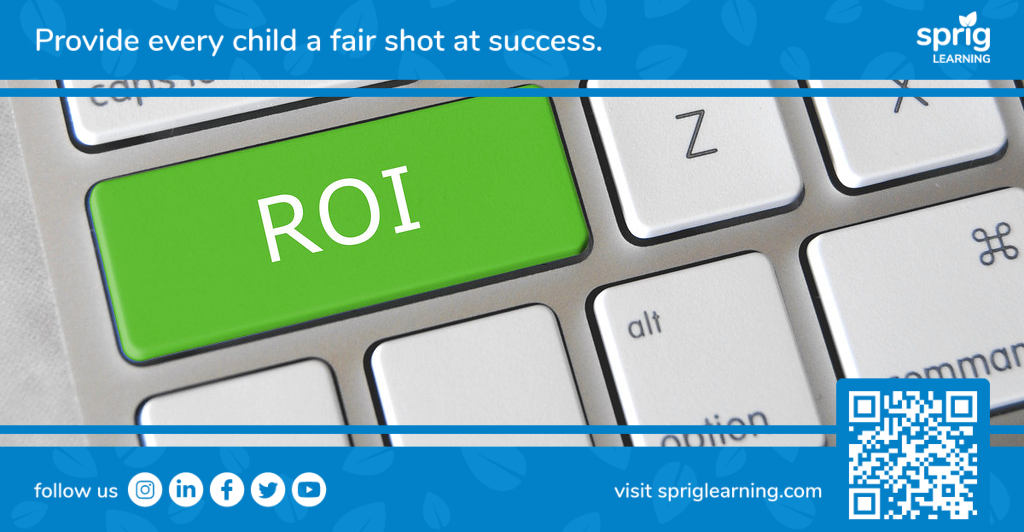There are different types of returns when it comes to investing in early childhood education (ECE), which includes the early primary grades. A large part of ECE consists of teaching literacy in language and math, as they are fundamental subjects crucial for academic success.
First, there is the societal return on investment (ROI).
ECE investment benefits the society at large. Professor Heckman, a Nobel Laureate and expert in the economics of human development, found that high-quality early learning investments can yield a 13% annual ROI per child, through better education, economic, health and social outcomes.
After considering all benefits to health, education and development of young students, and the positive spillover effects to the society, such as increased employment and safety in the future, there is a 4 to 9 times ROI over the lifetime of the student.
Almost 80% of prekindergarten and elementary schools in the US are public. By educating early learners, they do a lot of good for society.
But these schools are still compared against each other in student success metrics such as attendance, proficiency scores in assessments, and graduation rates.
This is because, other than societal ROI, there is also the all important school ROI, which increases accountability on the part of publicly funded institutions.
Education leaders do not seek a monetary return on their investments, but they do seek greater student learning and cost-efficiency. This is called the academic return on investment for schools. This article is about increasing the academic return on investment through early literacy initiatives.
Correct Approach to Academic Return on Investment (ROI)

It’s important to understand the expected return from any investment, because there is a limited budget and great opportunity cost for funds which could be used elsewhere to improve the school.
The academic ROI focuses ultimately on student and teacher benefit.
Teachers instruct and manage students while they are at school, which is a huge factor in affecting academic performance.
Other major contributing factors to academic performance are the student’s learning environment and situation at home, and their unique characteristics as early learners.
But even these two things can be shaped by teachers, by collaborating with parents and fairly assessing them at school respectively.
Simply said, for high academic ROI, every dollar spent has to either benefit the student or teacher.
Academic ROI seeks to maximize achievement for the greatest number of students. It is formulated by multiplying the learning gains for each student by the total number of students helped, and dividing this sum by the investment, or the total amount spent for the result.
By calculating the academic rate of investment in this way, the former superintendent of Arlington Public Schools, reduced the number of K-5 students reading below grade level by 65%, and increased the proficiency rate of students with special needs by almost 25%.
When used correctly, the academic ROI equation leads to positive results. It makes school administrators take the following into account:
- The total academic gains by all students (gains maximization).
- The total cost of such gains (cost-efficiency)
Adopting a Student-centered Viewpoint for Academic ROI by Improving Early Literacy Performance

Often during ROI analysis, the district will evaluate and compare different initiatives such as professional development programs, investment in technology (e.g., iPads), and after school tutoring, etc.
This approach makes sense as administrators look to add and cut items from the budget at the end of the fiscal year.
But it does not address the issue of academic return head-on.
In order to do that, there needs to be a student-centered viewpoint which considers the overall impact on student academic gains and the associated costs.
ER Strategies (ERS), the MA based non-profit partner to hundreds of school systems, recommends asking “which resources will meet this need”, instead of “which program is better”?
The first step is the identification of the core need.
In this case, because this article is about early literacy, the need is to improve student proficiency scores in language and math. These scores took a hit after the pandemic and are still in recovery mode.
ERS encourages system-wide thinking that spans departmental boundaries.
By solely focusing on what will improve early literacy performance and its associated cost drivers, it is possible to come up with cost-efficient solutions that will maximize academic gains.
Thinking About a Healthy Academic ROI

In a study from small school districts, 7 superintendents unanimously said that the acceptance of out-of-district transfers was a strategy for maintaining the district’s financial well-being.
Increasing the efficiency in personnel was another strategy everyone agreed upon. This was achieved via cutting and combining staff positions and recruiting and retaining high-quality employees.
Adopting the student-centered view to ROI, and looking at the goals these initiatives are trying to achieve, we can come to the following conclusions.
- There is a need for enrolling more students.
- There is a need for maintaining an efficient roster of teachers and staff that will deliver high-quality education to students.
Having understood these goals, it’s now possible to think of alternate solutions, instead of only focusing on line items in the budget.
For example, the two goals can be summed up to ask, how can each teacher, staff and administrator be better equipped so they can handle the intake, management, instruction, assessment, and personalization of education for every student, old and new, that comes to the district?
There are many answers to the question, of course.
This type of thinking allows the decision maker to consider the maximum benefit that can be achieved for the students with the smallest input. In other words, it’s very conducive for a healthy academic ROI.
How to Increase Early Literacy Academic ROI

It helps when the core need of students is identified from the start.
In the following case, one big public school district had already set out to improve academic ROI by increasing early literacy performance for their students.
Philadelphia’s public school system posted among the largest gains in English and Math proficiency scores out of all the big urban school districts.
They achieved this by standardizing the curriculum. All students would learn what was agreed to be the best curriculum at the time for early literacy success.
Such wide-implementation of a standard curriculum also led to greater collaboration practices, whereby knowledge could be easily transferred between schools.
Elementary school students doubled their time spent on English and Math, two hours on English and 90 minutes on math respectively.
Benchmark testing was performed every six weeks to help teachers identify what subjects required more instruction time, or more advanced instruction.
Class sizes were reduced in over 2,000 classrooms and over 200 academic coaches were added to the roster to handle deficiencies in literacy and numeracy.
Thus, by focusing on early literacy from the beginning, they were able to cost-efficiently invest in:
- standardizing the curriculum.
- increasing instruction time.
- instituting more benchmark testing.
- reducing class sizes.
- employing reading specialists.
Challenge question to you (the reader) to inspire student-centered academic ROI: Working with a tight budget, and having narrowed down these 5 investment items, is there a way to be more cost-efficient?
Early Literacy Performance for Increasing Budget
Thus far, we have focused on cost-efficiency, and rightly so, as it’s one half of the academic ROI equation and is more short-term oriented. Schools have to work within the framework of budgets, which makes them super mindful about maximizing the benefit of every expense.
When trying to seek the best improvements with a limited budget however, the question has to be asked, what type of investment will best yield long-term returns, such as expanding the size of the budget altogether?
Improving student academic gains early on, such as raising the early literacy performance, is one of the ways to ensure both short-term and long-term gains to the school.
The budget can be increased for a school district if there are more students, or if more people buy properties in that school district. But this influx of population into the area will not happen unless people see that the school is in fact renowned for delivering student success.
We already know that early literacy is the single biggest driver of student success in the early grades, but also throughout kindergarten to Grade 12.
So it’s a matter of prioritizing early literacy initiatives in the budget.
Even for schools in low-income districts that receive federal grants, the goal should be to attract new residents in the community, because only 8% of a public school’s funding comes from federal programs like Title 1.
Investing. Not Spending.

To recap, there are many superintendents who favor an academic ROI approach to make decisions about spending. The three most important metrics stated are effects on student learning, number of students served, and cost per student.
A study of 50 school districts showed that the dual goal of increasing student learning while also increasing cost-effectiveness is achievable.
In early childhood and elementary education, calculating ROI is an essential step to increasing accountability for student success.
For private schools which are funded by tuition fees, there is a greater impetus to track where the money is being spent. In the public sector, however, there are many streams of funds at both the state and federal levels. So it can be overwhelming to do a proper ROI analysis that forecasts what results are to be expected.
At times, it can feel like just spending money, and not investing it for an expected return. But when the funds are invested specifically for a certain return, such as raising early literacy performances, it’s good for both short- and long-term student success as well as the district’s financial well-being.
Sprig Learning is a purpose-built company that develops holistic and inclusive early learning programs. Sprig Reading is currently being developed for teachers, which streamlines a Science of Reading based curriculum for easy teacher application.
To discuss the cost-effectiveness and return potential of such a solution, please get in touch with us.

